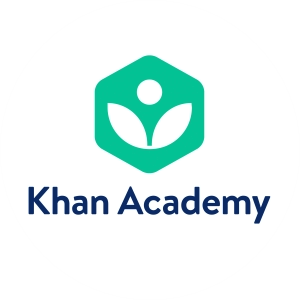
-
Khan Academy – Detailed Explanation : Offers a wide range of lessons, including programming and technical skills.
Khan Academy is a non-profit educational platform offering high-quality, free educational content. It provides resources for students, teachers, and learners of all ages across a wide range of subjects, from Mathematics to History and Computer Science.
1- On which platform are the tools used?
Khan Academy is accessible through multiple platforms, allowing learners to access the content at their convenience:
✅ Web Platform:
- Accessible via any modern web browser (Google Chrome, Mozilla Firefox, Safari, Microsoft Edge).
- The website is responsive, meaning it works on both desktop and mobile browsers.
✅ Mobile Platforms:
- iOS: Available on the App Store for iPhones and iPads.
- Android: Available on the Google Play Store for Android devices.
2- What hardware requirements are needed?
Khan Academy is a lightweight platform, and its requirements are minimal:
Minimum Requirements (Basic Use)
- Processor: Any modern processor (Intel or AMD)
- RAM: 2GB RAM
- Storage: 100MB disk space
- Internet: Stable internet connection
Recommended Requirements
- Processor: Intel i3/i5 or AMD Ryzen 3/5
- RAM: 4GB or more RAM
- Storage: SSD for faster loading
- Internet Speed: 3 Mbps or higher
3- Installation and Membership Stages
Installation Steps
For Desktop (Web Version):
- Go to the official Khan Academy website at https://www.khanacademy.org.
- Create an account or log in using an email address or Google/Facebook account.
- After logging in, you can start using all the resources right away.
For Mobile (iOS & Android):
- Download the Khan Academy app from the App Store (iOS) or Google Play Store (Android).
- Open the app and sign up or log in with your credentials.
- Start accessing the educational content after logging in.
Membership & Sign-Up Process
- Sign up as a student, parent, or teacher.
- Create a learning profile by selecting the subjects and grade levels you want to explore.
- Teachers can create classrooms and assign tasks or track progress for students.
- Parents can monitor their child’s progress and set up learning plans.
4- What can it be used for?
Khan Academy offers educational content and tools for learners at different levels and across various subjects. Here’s how it can be used:
✅ Interactive Lessons – Khan Academy offers a wide variety of video lessons on subjects like Math, Science, History, Economics, Computer Programming, and more.
✅ Practice Exercises – After watching lessons, students can practice what they’ve learned with interactive quizzes and exercises.
✅ Personalized Learning – Learners can progress through content at their own pace, earning badges and tracking their progress.
✅ Teacher Resources – Teachers can assign specific content, track student performance, and provide real-time feedback on assignments.
✅ Parent Monitoring – Parents can track their child’s progress, understand where they are struggling, and provide support.Example Uses
- Students: Prepare for exams, improve skills in subjects, or learn new topics at their own pace.
- Teachers: Use Khan Academy content in the classroom to supplement teaching and help with differentiated instruction.
- Parents: Support their children with learning outside the classroom.
5- What is its prominent feature compared to other tools?
🟢 Completely Free and High-Quality Content – Khan Academy provides all its content free of charge, offering high-quality educational resources that rival many paid platforms.
🟢 Comprehensive Coverage – It covers a wide range of subjects across different levels from elementary to college-level material.
🟢 Personalized Learning – Khan Academy allows students to learn at their own pace, adjusting to their individual learning styles and needs.
🟢 Progress Tracking – Both students and teachers can track progress through real-time reports and feedback on exercises and lessons.
🟢 Gamified Learning – Students earn badges and rewards as they complete lessons, keeping them motivated.
🟢 Integration with Classroom – Teachers can integrate Khan Academy into their classroom environment and tailor it to fit their curriculum.6- Sample application made with pictures
Example: Learning Mathematics Using Khan Academy
Step 1: Choose a Subject
- Students can choose a subject, such as Algebra, and pick a specific topic (e.g., Solving Linear Equations).
Step 2: Watch Instructional Videos
- A video lesson explains the concept in detail.
Step 3: Complete Practice Exercises
- After watching the video, students practice solving problems with interactive exercises.
Step 4: Track Progress
- Students can see their performance and earn badges for progress.
📌 Example Screenshot:
7- Which courses can it be used in and is compatible with?
Khan Academy is compatible with a wide range of subjects and educational levels:
✅ Core Subjects
- Mathematics (from basic arithmetic to calculus)
- Science (physics, chemistry, biology, and more)
- Economics & Finance
- History (US history, world history, etc.)
- Computer Programming (introduction to coding, JavaScript, SQL, etc.)
- Art History
- Test Preparation (e.g., SAT, LSAT, GMAT, etc.)
✅ Grade Levels
- K-12: From elementary to high school.
- College-Level: College algebra, chemistry, and more.
✅ Compatible with
- Vocational Education: Khan Academy’s math, science, and programming courses are useful for vocational students looking to build skills in technical subjects.
- Teacher Training: Teachers can use Khan Academy’s resources to improve their own knowledge or find materials to help teach specific topics.
8- Is it free?
✅ Yes, Khan Academy is completely free to use.
- All videos, exercises, and resources are available at no cost to students, teachers, and parents.
- Khan Academy relies on donations and grants to support its operations, making it accessible to everyone.
9- Links Related to Khan Academy
🔗 Official Website: https://www.khanacademy.org
🔗 Khan Academy on YouTube: https://www.youtube.com/user/khanacademy
🔗 Download Khan Academy (App): App Store (iOS) | Google Play Store (Android)
🔗 Khan Academy Help Center: https://support.khanacademy.org
🔗 Khan Academy for Teachers: https://www.khanacademy.org/educators